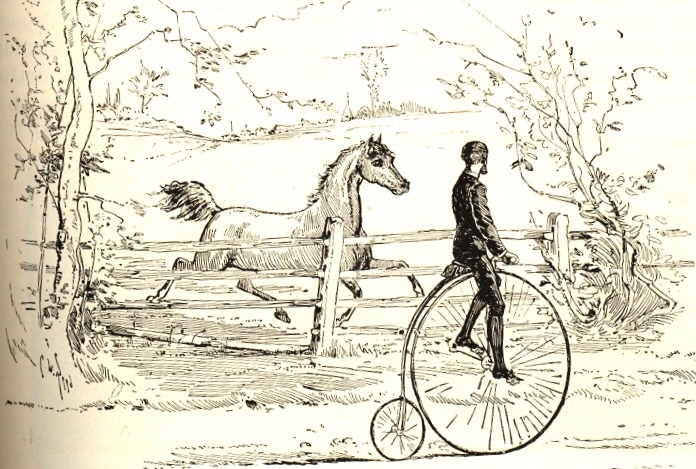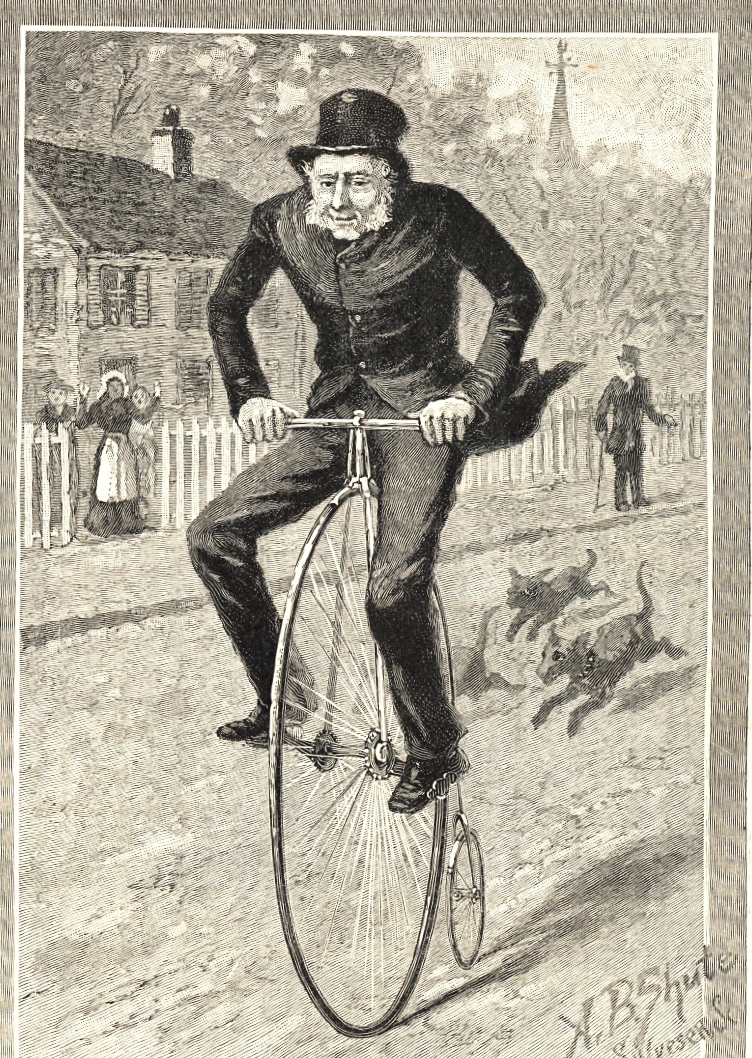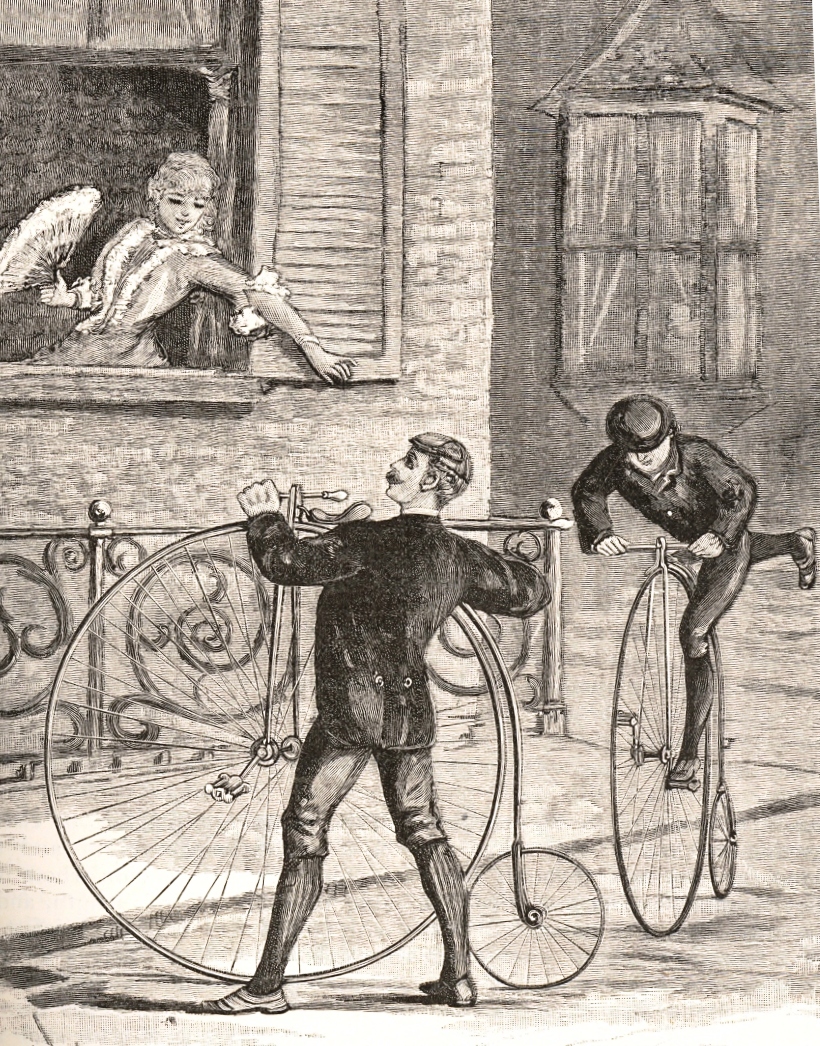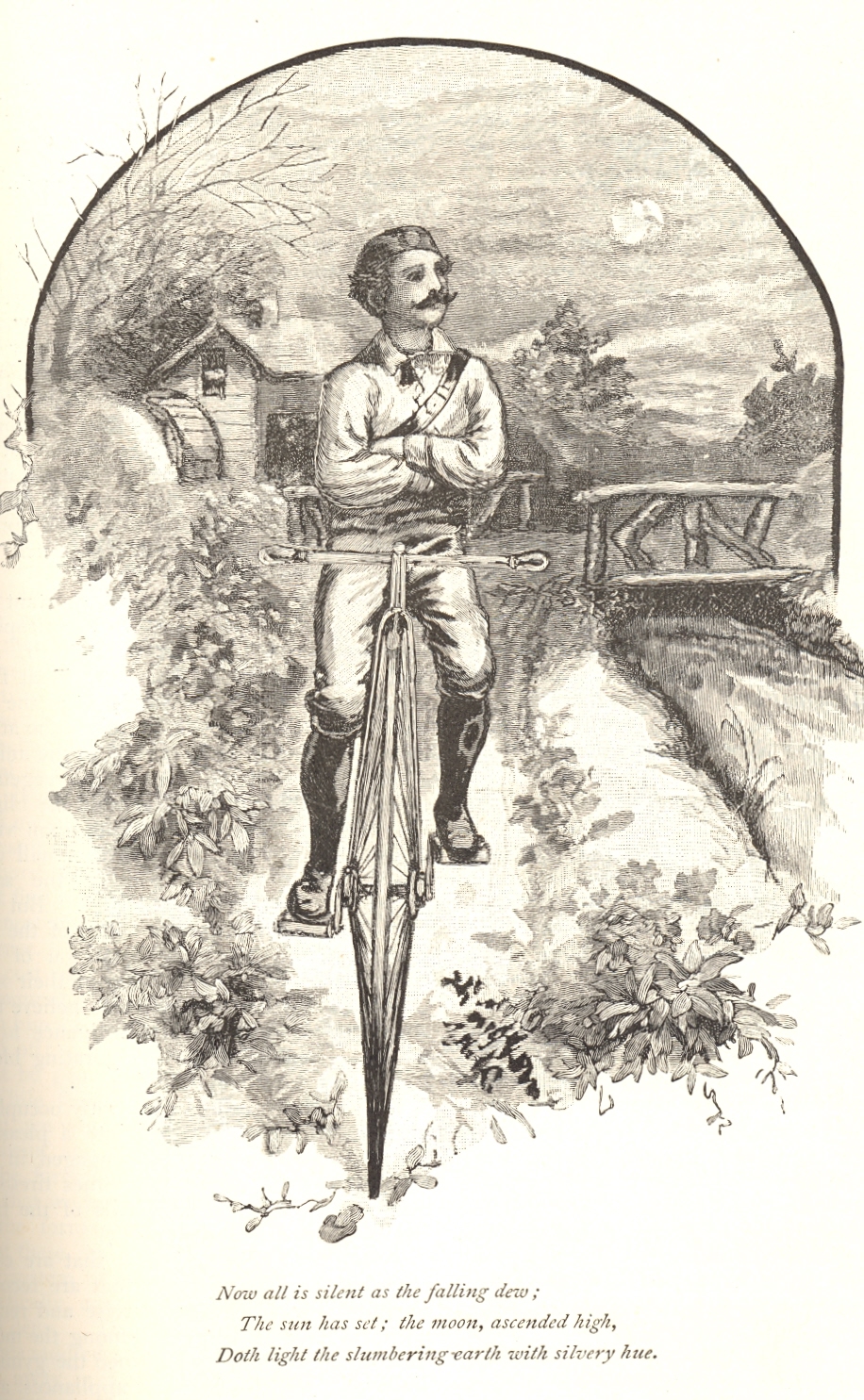NEWSLETTER OF THE NORTH MANCHESTER HISTORICAL SOCIETY,
August 2017
High-Wheelers, Horseless Carriages,
and Highway Maps, Part One
by
John Knarr
Thesis: The growing popularity of bicycles in the late 1800s and of automobiles
in the early 1900s gave impetus to an improvement in our road infrastructure and
navigational aids. GOOGLE MAPS of today has had roots and precedent which
developed more than one hundred years ago.
Editor’s
Note: In recent years a significant collection of our local newspaper North
Manchester Journal (1877-1894) has been digitized and made accessible at
newspaperarchive.com. One can now browse, read, search, clip, paste and save
articles from these issues. Some
information on early bicycles in our community has been retrieved from this
digital archive. For the sake of brevity, the North Manchester Journal=NMJ.
EARLY
BICYCLES
The 1876 Philadelphia Centennial Exposition introduced the English high-wheeler
(or ordinary) to the American public. [The Indiana Historian, Dec 1996,
p. 3] The earliest mention of bicycles found in our local media was in 1878.
Observations of European bicycle activity, especially in France and
England, were then being made. In England the bicycle business was assuming
importance. There were 130 bicycle manufacturers and 60,000 bicycles in
existence in the London area. [NMJ, Aug 29, 1878] There was also described “a
bicycle of colossal dimensions” with a wheel nearly eight feet tall and the
rider’s head some twelve feet from the ground. [NMJ, Dec 5, 1878, p. 4]
The following excerpts from an article written with a Boston byline in
1879 which appeared on page one [NMJ, Jan 23, 1879] entitled “The Winged Heel:
Some Interesting Facts and Reflections Relating to Bicycle Navigation” were
suffused with considerable enthusiasm and optimism. The “exhilaration” and “ecstacy”
of bicycling were highlighted. In this article, the inherent dangers and some of
the reality of riding were glossed over; taking headers and being pitched
forward up and over the handlebars was a no-mention. Rough and rutted roads,
taking spills, and ending with bruises, cuts, or broken bones were topics, while
promoting early bicycling activity, to be avoided or glossed over! And the
challenges of mounting and dismounting the high-wheelers were downplayed:
“Mounted on his fifty-two inch wheel with the wind humming in the spokes
and the mile-stones flitting behind him, the bicyclist appropriates the
aesthetic meaning of the “winged heel” with which the ancients endowed the
messenger of the gods. The prophetic myth of the wise and athletic Greeks has
become a modern reality. To get over the ground and through the water in the
quickest manner is the goal for which ardent spirits in all ages have put forth
their best endeavors. The bicycle ranks among those gifts of science to man, by
which he is enabled to supplement his own puny powers with the exhaustless
forces around him. He sits in the saddle, and all nature is but a four-footed
beast to do his bidding. Why should he go a-foot, when he can ride a mustang of
steel, who knows his rider and never needs a lasso? This is no boy’s plaything.
There are plenty of men, and their numbers are increasing, who prefer it on some
accounts to a horse or yacht. Bicycling is walking, with scientific economy of
expended energy. It is an extension of the person, an enlargement of the bodily
functions in the direction of locomotion. It seems difficult to the uninitiated
to keep one’s balance on a vertical wheel, but the mechanical principle, or
knack of the thing, is as easily acquired as skating, and much easier than to
balance a load on the head. …The exhilaration of bicycling must be felt to be
appreciated. With the wind singing in your ears, and the mind as well as body in
a higher plane, there is an ecstacy of triumph over inertia, gravitation and the
other lazy ties that bind us. You are traveling; not being traveled. You look
upon horse machines with contempt, and even your old acquaintance the
pedestrian, with pity. The saddle, firm as a pillar, bears up your 170 pounds
dead weight, which in walking you have to raise up and lower with every step.
Your body is at rest; the legs are in motion, and your walking stroke geared up
to a wheel thirteen feet in circumference, shod with rubber. You sit and glide
with scarcely perceptible jar, but the towns and villages dwindle as you pass
through them. The birds that cleave the air have a like motion with yourself. By
moonlight on a hard road the enjoyment of yourself as a centaur is intense. To
see a close-knit, sun-browned fellow in fitting costume, shooting down a long
hill with perfect composure, dispensing with hands or feet, or both, at a pace
exceeding that of a race horse, is fearful, but it is pretty. Experts go up hill
or down with acquired ease, and in single ruts for miles at the sides of country
roads; but the better the road the better the ride, which is equally true of all
other vehicles. All modes of transit along the highways of travel, ox-power,
horse-power, steam-power, electric or any other motor, pedestrianism and
pedalism, have each their hour and right of way for the time being according to
law. Though there are difficulties to be overcome, we claim that any one of
ordinary patience and pluck can learn to ride a bicycle satisfactorily. The feat
is somewhat gyroscopic and less than it looks to be. Once learned, it is an
elegant and healthful accomplishment, worth all the time and money it costs. …As
to safety in general, the bicycle being a machine is safer than a horse, for the
latter has a will of his own to be consulted and controlled. …The mechanical
principles are good, as far as they go, and each new improvement (there is
plenty of room yet) gives it a firmer hold with the athletic. Every boy in the
coming generation should be trained to it, commencing with the velocipede at an
early age. Get a good machine by all means; and, if you can afford it, indulge
in the luxury of a first-class article; one that you can ride with the loose
reign of confidence, throwing your entire muscle into a level spurt or a steep
ascent, with no nervous apprehension of a badly made screw, or a loose rubber,
or subsequent repairs. …Indeed the bicycle may be considerable as the outcrop of
the age, the necessity for rapid transit having given birth to the invention.
With full faith in the progress of things, we look beyond this machine of
to-day, and see private carriages to and from on our best roads, impelled by
small petroleum engines of light horse-power. This is a favorite subject with
some of our advanced mechanicians, and by them considered so feasible as to be
almost a reality. Then the first machine comes along, and it will come in due
time, it will be another winged heel. We give it in advance a hearty welcome.”
The first local sighting of a bicycle reported in our local newspaper
took place in 1883. [NMJ July 19, 1883] A young man from Springfield, Ohio, was
spotted riding around the streets. His bicycle was made of wood and the wheels
were large and heavy. The frame was wooden, as were the handlebars, wheels and
spokes. He had made the trip from
Ohio in two days riding. [Ed:
Starting in the early 1800s the earliest recorded bicycles (velocipede) were
constructed mostly from wood. See Wikipedia, “Wooden Bicycle” and “History of
the bicycle”] Ten years after the appearance in North Manchester of a wooden
bicycle ridden by a “Buckeye”, J.R. Stemm rode in from Bloomington on a later
model bicycle, and then left a few days afterwards for Galion, Ohio. [NMJ Sep 7,
1893]
In 1884, a young Englishman, Thomas Steves, even made a cross-country
trip across the United States on his bicycle, a 50 inch Columbia high wheel. He
left San Francisco on April 22, arriving in Chicago. He then rolled onward to
New York by way of Cleveland, Buffalo and Albany. [NMJ, Jul 10, 1884] Steves
covered over 3,300 miles in 104 days. (Note: Did you know that there exists a
Guinness World Record for High Wheels Trans Continental Crossing? Steve Carter
of Plainfield, Indiana, recently held this record in 1992 covering 3428 miles in
33 days and 7 hours with his 1885 Columbia.)
In 1888 Bert Spencer, only ten years of age, rode over from Huntington to
visit his uncle in North Manchester, Walter Brookover, making the trip in about
three hours. [NMJ Aug 23, 1888] Bicycle clubs were being formed during this time
period. Kokomo had a bicycle club of 20 members in 1885. [NMJ May 21, 1885] In
1895 a bicycle club was organized in North Manchester. [NMJ April 25, 1895]
Known as the Blue Cross cycle club, the members reportedly were considering a
club run to Bluffton “in the near future”. By the late 1890s Indianapolis had
nearly one hundred bicycle clubs. [Pryor Dodge, The Bicycle (1996), p.
82]
In the summer of 1885, our local fairgrounds (where the Peabody
Retirement Community is now located) hosted both horse trotting races and
bicycle races. [NMJ June 18 and 25, 1885] Bicycle racing at the fairgrounds took
place in subsequent years. [NMJ June 23, 1887] At a local skating rink, on
location at Hamilton’s Opera House on Main Street, Charlie Henney raced his
bicycle against Walter Laidlaw on roller skates. Laidlaw was described as “the
best skater in the city” and Laidlaw won the race by one lap, “the score
standing 14 to 15”. [NMJ Jan 14, 1886]
The July 4th celebratory
events at the local fairgrounds in 1893 included bicycle races, along with foot
races, climbing greased poles, a shooting tournament sponsored by the local gun
club, and a baseball game between the Fire Department’s Hose Company and the
Hook and Ladder Company. [NMJ June 22, 1893] Bicycle racing became a popular
sport with monetary prizes or “premiums” awarded. In 1893 a five-mile bicycle
race took place at the local fairground. The race was won by Jack Summerland of
Wabash. One of the prizes included an accident insurance policy for thirty days
given by J.P. Watkins. Just before the policy expired, Summerland had an
accident and the insurance agent Mr. Watkins sent him five dollars. [NMJ, Oct 5,
1893] In 1892 a “professional bicycle rider” reportedly made a 1000-mile bicycle
trip. [NMJ, Aug 4, 1892]
Besides Charlie Henney, other early owners of local bicycles included Jess
Burdge and John Mills. John Mills purchased in 1887 an American Star bicycle for
$75.00: “It has the little wheel in front and is a beauty.” [NMJ, May 19, 1887]
Mills took his bicycle to Dayton, Ohio, and then rode over to Eaton and West
Alexandria. After visiting friends, he then made the trip to Indianapolis “on
his wheel” in “two half days” and returned to North Manchester on the train.
[NMJ Oct 4, 1888] At that time, the American Star bicycle was being advertised
as “a practical roadster, safe from headers or other dangerous falls.”
In 1885 while Congress was being lobbied for road surface improvements by
bicyclists, an American Star bicycle was ridden down the U.S. Capitol steps as a
publicity stunt to demonstrate its stable design. While the small front wheel
may have made it less likely to pitch over forwards when hitting a road
obstacle, one had to be careful not to fall over backward! Jess Burdge became an
owner of a Columbia bicycle in 1887. Our newspaper reported that “it is likely
that several wheels will be owned in the city before the summer is over.” [NMJ
May 26, 1887] Burdge even contemplated making a trip to Kansas on his bicycle to
visit his brother-in-law, Waldo Brown, who resided in Newton KS. [NMJ June 2,
1887]
As bicycle popularity grew, bicycle-related businesses sprouted up and various
entrepreneurs emerged. This business phenomenon included the sale of new and
used bicycles and all sorts of bicycle accessories such as bells, lamps, locks,
oil cans, tire pumps, wrenches (spoke, fixed, adjustable), other repair tools,
cement, enamel, articles of clothing, etc., along with the repair of bicycles.
F.J. Rettig advertised locally that his specialty was “Bicycle repairing
of all kinds”. [NMJ, May 22, 1890] Rettig also sold bicycles, the Steel Cruiser
($75.00) and the Peeriell ($58.00). According to Rettig’s ads “Bicycles and guns
taken in exchange for wheels.” [NMJ, May 22, 1890]
Brown’s novelty shop on Mill Street advertised “a good second-hand
bicycle will be sold cheap”. [NMJ Oct 6 and Oct 27, 1892] In 1893 Brown &
Isenbarger’s Novelty and Repair Shop was placing large display ads for Arrow and
Ariel Bicycles: “List price $150. Our price $125”. [NMJ Aug 3 and Aug 17, 1893]
Brown & Isenbarger did “All kinds of Bicycle Repairing on short notice” and also
had “Wheels to rent at 25 cents per hour”. J.S. Lautzenhiser advertised in
display ads the Patee Bicycles with “polished tool steel bearings that are dust
proof”. [NMJ May 14, 1896] Ira Perry and Leo Rager had sold their bicycle agency
to J.S. Lautzenhiser in 1896. [NMJ, May 7, 1896]. Our Center for History has a
photo circa 1900 of the Cyclery Shop at the southwest corner of Market and Main
streets. Olinger and Warvel had
opened their Cyclery shop in 1899 on West Main near the Rays of Light office.
Bicycle historians point to the 1890s as the “golden age” and apex of
bicycle mania. The Henry Ford of the bicycle world was probably Chicago’s Adolph
Schoeninger and his Western Wheel Works. The Western Wheel Co. was building the
tandem bicycle, and lyrics to “A Bicycle Built for Two” were composed by Harry
Dacre in 1892: “Daisy, Daisy, give me your answer do/I’m half crazy all for the
love of you/It won’t be a stylish marriage/I can’t afford a carriage/But you’ll
look sweet upon the seat/Of a bicycle built for two./We will go tandem as man
and wife/Daisy,Daisy/Peddling away down the road of life/I and my Daisy Bell.”
The Town of North Manchester passed an ordinance to keep bicycle riders
off the sidewalks, and Marshal Newt Lautzenhiser said he “will arrest all
offenders. The bicycle must keep in the street.” [NMJ April 6, 1893]
Bicyclists and their bicycles often spooked the horses, or they sometimes
found occasion to collide with the teams on the roadways. Several instances were
remarked in the local media of such encounters. One such account happened when
Snideman’s and Peabody’s bicycles frightened Charles Delaughter’s team coming
from Stephen Harter’s funeral with a wagon load of people in 1893:
“There came near being a disastrous runaway in the north part of town one
day last week. Charles Delaughter was coming home from Stephen Harter’s funeral
with a wagon load of people when his team was frightened at some bicycles in the
road and tore loose from the wagon, breaking the doubletree and harness.
Fortunately no one was hurt. The bicycles were ridden by Chlor Snideman and a
boy by name of Peabody. There is a story out that the boys ran into the team but
they claim that as they passed by on their wheels the horses jumped and broke a
line which rendered them unmanageable. Be it as it may it is a well recognized
fact that horses scare at bicycles and persons riding them should exercise much
caution in riding around where there are horses. [NMJ Apr 6, 1893]”
In the 1890s the State of Indiana’s Department of Statistics began
tracking and tabulating statistics for those employed in businesses related to
Bicycles and Accessories. [See e.g. Seventh Biennial Report of the Department
of Statistics for 1897 and 1898, p. 95.] These statistics included:
employees’ average age, average number of hours work per day, average daily
wages received, average number days employed, average number in family, average
monthly rent, average annual savings, average amount of life insurance carried,
average amount of accident insurance carried. The statistics were put in tabular
format for bicycle shop foremen, filers, polishers, machinists, enamellers,
machine hands, assemblers, engineers, wheel builders, toolmakers, brazers,
finishers, electroplaters, blacksmiths, stock keepers, packers, painters, common
labor, etc.
National and local publications of all sorts covered the bicycle hobby,
sport and industry. Magazines, instructional and technical manuals, features on
“bicycle etiquette”, newsletters, bulletins, books, novels, short stories,
articles, race schedules, catalogues, maps and tour guides, prints, photography,
artwork and associated works were published.
In 1879 an attorney Charles Pratt wrote the book, The American Bicycler.
In 1880 the League of American Wheelmen was founded with Pratt as its first
president. Their publication The
Wheelman started publishing in 1882. This association promoted the general
interests of cycling, defended and protected the rights of wheelmen, facilitated
touring, promoted cycle racing, and gave priority to lobbying for the
improvement in the public roads and highways.
The organization of wheelmen began publishing in 1891 the Good Roads
Magazine. In 1896 the Road Book of Indiana was published by the
Indiana Division of the League of American Wheelmen. The latter publication
contained sectional maps of the entire state of Indiana, showing all good
cycling roads, designating the good from the bad, identifying gravel and dirt
roads, and marking hills in red ink. An alphabetical index enabled the user to
find any town or hamlet in Indiana quickly. It listed hotels and accommodations
available in different cities, as well as bicycle repair shops.
In 1898 a Tour Book of Indiana was compiled by the Indiana
Division of the League of American Wheelmen. It described 155 routes throughout
the state and was indexed by city name. Distances between points were offered in
tabular format for the different routes. The conditions of the roads were
described, as well as the kind of road and grade of road.
Bicycles were the precursors to the automobile. The stage had been set.
Bicycles “paved the way” in manufacturing, employment, marketing, accessories,
repair tools, insurance, laws and ordinances, road improvement, road maps,
signage, safety, riding outfits, entrepreneurial and inventive spirit, mobility
and an associated freedom of movement.
Note:
The Editor of this Newsletter still has his 20" Schwinn bicycle he received as a
birthday gift some seventy years ago. That time span represents roughly fifty
percent of the total time frame referenced by the bicycling world. Memories and
delightful experiences in the 1940s and 1950s of pedaling through the bucolic
countryside along the gravelly roads between North Manchester and South Whitley
have lasted a lifetime. The first American bicycle was produced in 1878 in
Boston (the Columbia model ordinary/high-wheeler). The so-called “safety
bicycle” with two nearly equal low wheels and chain drive was first produced in
1885. John Dunlop patented the pneumatic tire in 1888 in England.
The bicycling images on the following pages are from the first issues of The
Wheelman, Vol. 1 (1882-1883):









































